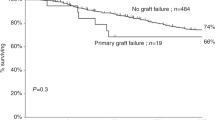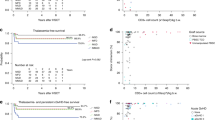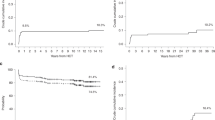Abstract
Thirty-two thalassemic patients with a median age of 7.7 years (range 3.4–26 years) were given a second HLA-identical related marrow transplant (BMT2) for graft failure. Four patients were in class 1 and 28 patients in classes 2 and 3. Twenty-one patients had full thalassemia recurrence (first group) and 11 patients had aplastic marrows (second group) either with or without residual donor marrow cells after the first BMT (BMT1). As conditioning regimen for BMT2 all but five patients received BUCY or CY in association with total lymphoid irradiation (TLI) and/or anti-lymphocyte globulin (ALG), whereas nine patients received a new preparative regimen with hydroxyurea, azathioprine, fludarabine before conditioning with BUCY. Twenty one of 31 evaluable patients (67.7%) had initial, and 16 (51.6%) had sustained engraftment. Ten patients (32.3%) failed to engraft. Overall and event-free survival for the entire group of patients were 49% and 33%, respectively, with a median follow-up of 4 years (range 0.6–14 years) for surviving patients. Event-free survival was higher in the second group of patients compared with the first group (41% vs 29%). The second group of patients appeared to have less graft failure compared with the first group (30% vs 63%; P = 0.1). Transplant-related mortality was 28%. A linear stepwise regression analysis revealed that occurrence of graft failure within 60 days after BMT1 (P = 0.04) and absence of residual donor marrow cells (P = 0.009) predicted for graft failure following BMT2, whereas the occurrence of graft failure after 60 days (P = 0.03) had a positive influence on survival following BMT2. The incidence of grade ⩾2 acute GVHD was low (14%). Eight of nine patients who received the new preparative regimen are alive, four without thalassemia. This study shows that BMT2 can be an effective therapy for a proportion of patients with poor survival expectancies despite conventional treatment.
This is a preview of subscription content, access via your institution
Access options
Subscribe to this journal
Receive 12 print issues and online access
$259.00 per year
only $21.58 per issue
Buy this article
- Purchase on Springer Link
- Instant access to full article PDF
Prices may be subject to local taxes which are calculated during checkout
Similar content being viewed by others
Author information
Authors and Affiliations
Rights and permissions
About this article
Cite this article
Gaziev, D., Polchi, P., Lucarelli, G. et al. Second marrow transplants for graft failure in patients with thalassemia. Bone Marrow Transplant 24, 1299–1306 (1999). https://doi.org/10.1038/sj.bmt.1702076
Received:
Accepted:
Published:
Issue Date:
DOI: https://doi.org/10.1038/sj.bmt.1702076
Keywords
This article is cited by
-
Salvage allogeneic hematopoietic SCT for primary graft failure in children
Bone Marrow Transplantation (2013)
-
Second hematopoietic SCT in patients with thalassemia recurrence following rejection of the first graft
Bone Marrow Transplantation (2008)
-
Nonmyeloablative stem cell transplantation with a haploidentical donor in a class 3 lucarelli severe thalassemia patient
Bone Marrow Transplantation (2004)
-
Hydroxyurea treatment for sickle cell disease: impact on haematopoietic stem cell transplantation's outcome
Bone Marrow Transplantation (2004)
-
Full chimerism in nonmyeloablative stem cell transplantation in a β-thalassemia major patient (class 3 Lucarelli)
Bone Marrow Transplantation (2002)



